Editorial
What a month! Keeping the home fires burning has taken up a lot of time and an unusual amount of effort in MEN Central this past month, but all looks better now apart from our aging sixteen year old Burmese, Chloe, who caused a panic by passing out! Seems she's developed high blood pressure and let me tell you, a passed-out cat is a pitiful sight. Our tiny woes are, of course, as nothing compared to the people in the US and Canada who have just been battered by the so-called Frakenstorm. The aftermath in New York City is something we here in Brisbane can relate to. High-rise buildings tend to place electrical plant in the basement, and once that has been flooded, you can't just drain it out turn the power back on. If it's anything like what our city went through, just finding the required replacement plant, and especially the people qualified to install, test, and certify it will take far longer than expected. But the resources available in the US are far more extensive than here in Australia, so here's hoping...
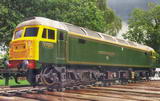
From time to time, I've suggested that reading outside your specialization is a Good Thing™. As an example, take a recent article which appeared in the Model Engineer on building a British Class 47 diesel electric locomotive in Gauge 1. The author, Ken Toone, chose an OS FS-30S Surpass four-stroke to drive a permanent magnet electric motor, acting as a generator to drive six electric motors—one for each pair of wheels. The four-stroke was chosen because it was quiet and the electric motor/generator because it could be used to remote start the OS by radio control. Other channels activated the glow plug power source, the engine throttle, speed control plus reverse for the drive motors, and an MP3 player for the "whistle". Ken found the generator acted as a very effective flywheel for the engine, which is run well below peak rpm. From his writing, it evident that he is not an experienced glow engine man, but nevertheless, he overcame tricky fuel feed problems and designed a special muffler with a centrifugal oil separator. He uses computer muffin-fans to provide air cooling for the OS, and to extract exhaust in a most scale-like way. His coach work is impeccable too. Hats off for a well thought out and out of the rut project. It certainly gave me ideas I'd not have had otherwise.
As you'll see, we can't seem to leave the subject of the Atom Minor Mk III alone. Personally, I can't look at the name without remembering an interview I once heard with British poet, Pam Ayres. In it, she mentions that she lived on a farm and once had a goat which she called "Morris". It seems that Morris fathered a kid, who they named "Morris Minor". I'm guessing less that 20% of MEN readers will get all of that one, but those who do will be smiling right now.
Now the Bad News. Australia Post has put their rates up again, substantially this time. I've been absorbing their rises for the past six years, but there are limits and we've reached them. Hence, you will notice a small change of between AUS$3.00 and $5.00 in the MEN DVD and Upgrades, and the MBI Plan Book on CD. For the Good News, note that the DVD includes a copy of the Plan Book, so no need to order both.
Gildings 2012
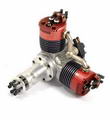
Gildings 14th Annual Vintage, Classis, and Modern Aero Engine Sale will take place on Saturday, November 3, 2012. This year there are 587 lots, including some very nice collectables, such as the Magnum V-twin pictured here, and Lot 587 itself—a Danish Viking 2.5cc diesel. As usual, estimated prices range from the reasonable to the incredible, though what they will eventually go for, if they "go" at all, is another matter. But before you rush to see what's available...
Warning, WARNING, Will Robertson! If you follow the link given in this item to the Gildings announcement page, you'll see a prominent "Download" button, virtually inviting you to click it thinking it's something you need to view the catalog. It is actually a link to an insidious piece of virus-ware called "WiseConvert". DO NOT install this thing! It does nothing useful and takes ages to get rid of. This is happening more and more and I damn for all time, forever, and unto eternity the website designers who design links like this to entice the unwary to download and install things like WiseConnect, and especially Babylon (which I still have not completely got rid of) in order to line their pockets with a few extra pennies. To see the actual auction catalog, simply click the far less obvious "Browse Catalog Online" link, located unobtrusively towards the upper right of the page.
More Must Be Better
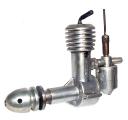
At first glance, this 1947 diesel is quite conventional, however there are a number of features which drag it out of the ordinary, well into the realms of the noteworthy. The engine is the Clan .9cc, from Glasgow and our review came about as I started entering hyperlinks for nine different diesels listed by Adrian Duncan at the start of his Thermite review. We had pages for eight of them and I knew I had a photo for the ninth, so decided to do a "quickie" review. What can I say? Like Popsie, it just 'growed. It's amazing what can be dug up when your Library is obscenely large, and you have people to help like ECJ head honcho, Tim Dannels, Les Stone, and others. This little 'fella may just get the MBI plan treatment before too long, too.
Fitzpatrick 60
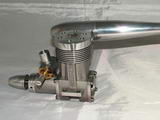
Back in the late 80's when I was returning to aero modeling via F2B aerobatics after a ten year hiatus, I remember eying the Fitzpatrick 61 advertisements and lusting after the engine on its looks alone. I was saved by the fact that it was a Schnuerle ported engine and so, most likely useless for control line stunt where we want the engine to reliably "switch" between what is popularly called "four cycle" and "two cycle". After reading David Janson's Fitzpatrick 60 review, it appears I was saved from even worse disappointment. The history of the engine is quite an eye-opener, but to me at least, the Fitzpatrick is a delightful piece of eye-candy and I'm sorry I didn't buy it just as a thing of beauty, if nothing else. For the eagle-eyed (you know who you are), the review should also clear up why I've called the the engine I passed on a "61", while Janson uses "60" in his review title.
It Ain't Half Hot Mum
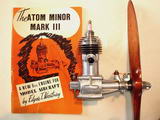
Readers in Commonwealth countries should recognize that title and the rest of you can look it up, or not. The oblique reference is to confirmation from Les Stone that, as mentioned last month, the crankcase of the Westbury Atom Minor Mk III runs too hot to touch, although it does run nicely. Engine design guru, Gordon Cornell has also weighed into the subject saying—quite correctly—that speculation is not worth a lot when tools like his ICE simulator are available which will model what is going on in the engine and allow you to alter individual parameters to evaluate changes before cutting metal. Gordon has sent the latest version to see what that might tell us. In the mean time, I've added pictures of Les' Atom Minor to his tribute page.
Mini Mills
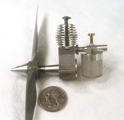
It should be obvious to all by now that a major character flaw means I'm unable to resist cute titles with multiple meanings, alliteration, double entendre, or obscure pop culture references. So I get a bit peeved when someone outdoes me in an email subject line—even worse, he may not have intended it that way! In our September 2012 Issue, we introduced you to Dave Miner's mini-Weaver. This month, Dave sent in a picture of his mini-Mills Mk I, and we'll return to why his title is "cute" later. The specs on the engine are a bore of 0.281", and a stroke of 0.432" for a displacement of 0.027 cuin (0.44 cc). Dave set the inlet duration at 104°, transfer 112°, and exhaust 132° These are good numbers for a piston ported engine, but despite that, Dave found that unlike his mini-Weaver, the mini-Mills was a bear to start, flooded easily, and was sensitive to compression and needle settings. The good news is that Dave has "sorted" the beast and provided some observations and tips to would-be builders of miniature diesels which you can read about in this month's Tech Tip.
Now, why is the seemingly harmless title "cute"? Well, in the 1950's when I was a lad, consuming the British magazine Aeromodeller cover to cover every month until said cover fell off, a popular generic term for an engine was a "mill". This has nothing to do with Mills Brothers engines, going much further back, and since Dave's email dealt with aspects of miniature model engines in general, and his reduced size Mills 1.3 Mk I in particular, the title becomes rather clever and I wish I'd thought of it first!
QSMEE Trophy Day
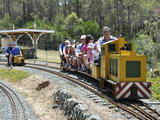
The Annual Trophy and Open Day for the Queensland Society of Model and Experimental Engineers (QSMEE) will be held on Sunday November 11 at their extensive track site in the bush. For the location, see our earlier announcement. It's not all live steam (and electrics) though; static displays will include a good diversity of model engineering from clocks to internal combustion. You may even spot me running a small diesel, or two.
New Books and Magazines This Month
It's about two hours since I finished reading this month's New Book. As I start putting my thoughts down, I don't know if it's going to a Five Star review, or a One. I may even decide that it's all to hard and not rate it at all. The book is yet another aviation related biography work, and not one I'd normally have bothered with, but my flying buddy bought it to take his mind off the arctic temperatures outside while stuck in Tasmania for a few weeks, not to mention the ravaging Tasmanian Devils in the streets. On his return, he passed it to me, wanting my opinion as a licensed pilot, so I figured I had to read it. As it turns out, I had no idea what I was letting myself in for.

Our subject is QF32, by Richard De Crespigny, Pan Macmillian Australia, 2012, ISBN 9781742611174 (paperback edition). The publishing history says the book has been reprinted five time, which says something for a book in its first year of publication. "QF32", as many will know, is the designation used by Qantas Airways aircraft operating the Singapore to Sydney route. The author had the privilege of being the Pilot In Command of this flight, flown on the occasion by VH-OQA, an Airbus A380—you know, the monster big one with two decks that can accommodate almost 500 passengers—when, shortly after leaving Changi, engine number two exploded. This particular aircraft was the first one of its type Qantas had taken delivery on in 2008, and only the sixth of its type delivered to customers. Coincidentally, Richard "Dick" Champion de Crespigny had been the skipper of this aircraft on its inaugural flight (Sydney-Los Angeles). The aircraft carries the name Nancy Bird-Walton, after the first woman in Australia to gain a pilot's license.
When reading autobiographies, one never knows whether the work is the author's, or a ghost writer. I'm not sure it matters. In any case, this one is well written, easy to read, and tells an engaging story of how our author became enthralled by aviation, managed to get himself into Point Cook (4000 apply, 40 are accepted), became a pilot in the Royal Australian Air Force (RAAF), and for a time Aide-de-Camp to two Australian Governors General (our titular Head of State, although not the political one). He relates several very interesting tales from his time in the RAAF, including the origin of the "brace" position for crashing, and the Australian F86 Sabre pilot who was the first to use it. Of interest to Australians, especially those who remember "The Dismissal" and Malcolm Fraser's subsequent loss to Bob Hawke, will be the stories of his time as Aide-de-Camp to Sir Ninian Stephen and Sir Zelman Cohen. During his RAAF flying career, Dick wanted to fly the F-111 and almost did, but circumstances found him driving the DHC-4 Caribou, the Bell Iriquois, and Macchi jet trainer, the latter at both extreme ends of his RAAF service, as pupil and instructor.
That takes us to page 83 of 358 (with two color plate sections). The remainder of the book relates Dick's experience at Qantas leading to Wednesday, November 3, 2010, when, at 10:01, shortly after departure and passing through 7,400 feet, the number two engine blew up catastrophically, severely damaging flight controls, electrical, hydraulic, fuel management, and other critical systems. We know the outcome. You may even remember it and the frenzy of inaccurate reporting the media indulged in before any real facts were known. The aircraft was landed safely with no injuries to anyone, except the aircraft, which took a year to repair. It could very easily have been different and our author pulls no punches in describing the actions on the flight deck and in the cabin.
It's an exciting read. I devoured the book in two can't-put-it-down sessions. So why did I say I was undecided about how to rank it, or even if to rank it? The answer starts about page 285 with everyone back on the ground and spirals into a real downer. The next Friday, Dick, several of his exhausted and drained flight crew, plus many of QF32's original passengers boarded a Qantas 747-400 to return to Australia. At only 2000 feet, the aircraft suffered a compressor blade failure and had to return to Singapore. Although nowhere near as severe as the episode of November 3, this was the second engine failure for Qantas in two days. Worse for QF32's crew was the compounding impact on already drained emotions. Dick openly describes the effects of his own post traumatic disorder and slow recovery. The book takes the reader—this one at least—from an emotional high of dealing with the in-flight emergency and successful landing, straight into a big emotional downer at the end from which it does not pick up. On finishing it, I felt utterly drained, and even now, as I edit this a day later, I'm still feeling vaguely depressed.
Ok. Decision time. I'm not going to forget this book easily, and I learned several things. I guess I have to give it Five Stars, but be warned, while there's a happy ending of sorts, it's somehow not uplifting; but life's like that, isn't it? 
Footnote: QF32 is available from Amazon for $15.95 and if you click the link, or image of the cover, you'll be taken to Amazon's web site and the Kindle version of the book—and you don't need an actual Kindle as Kindle reader apps are available for PC's, laptops, tablets, and smart 'phones. This is the first time I've linked to an e-book, the reason being that Amazon does not seem to be carrying the physical editions. Perhaps the shape of things to come?
Engine Of The Month: Thermite
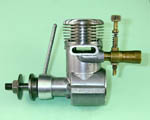
As if we don't have enough already, here's Yet Another Mite. There's the Milford Mite, the Majesco Mite, and even the Mite Mite! Now we have the Ther-mite. Ok, I had to stretch a bit to make that one work, but do be prepared to be surprised by what Adrian has for us this month, a diesel from the US of A with eccentric crankshaft compression adjustment which pre-dates all the usual suspects, and has been largely forgotten by the world at large. There's a connection to another famous engine brand too, which I won't reveal here in order to maintain some sense of dramatic tension. I'm really glad Adrian researched this one, as the process of formatting and hyperlinking his raw text caused me to research and write up another eccentric crankshaft diesel, leading to more surprises, as mentioned in the More Must Be Better item.
Tech Tip of the Month
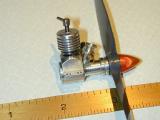
Building any small internal combustion engine that runs is an achievement. As skills increase, many model engineers enjoy the challenge lurking at both ends of the spectrum which extends either side of the simple, single cylinder engine. At one end are the multi-cylinder masterpieces. At the other are the really small engines, construction of which requires very precise fits if the engine is to run.
This issue of Model Engine News has already showcased one of Dave Miner's miniature diesels, a 0.44cc Mini-Mills. Dave had some trouble with this engine and offers his observations in the hope that they may encourage others to take up the challenge of building mini diesels, or to have another try at the recalcitrant example they've not got to run (yet). Here's what Dave found while sorting out his Mini Mills:
- Primary compression is critical! My Mini Mills had a leak in the liner to case fit. What happens is the engine will draw fuel from the fuel tank, but will not transfer. This loads up the crank case and causes flooding. I coated the liner with silicon vacuum grease and put it back together. The engine now runs perfectly and has a lot of power, 10,000 rpm plus on a 6x3 prop, starting in just a few flips.
- Mini engines are a bit sensitive to mixture, so when making a needle for a micro engine, the taper should be longer and finer. You should also choose a very fine thread.
- The cylinder taper should be a bit less for a micro engine. I would say 0 to .0003 taper.
- A fuel with 50% either content is good for initial start and establishing the basic settings, but much more power is available with standard fuel. A well built micro engine will start and run well on standard fuel.
- I'm not totally convinced that a deflector piston is all that effective. If I were to build another Mini Mills, I think that I would use a flat top piston and change port position as necessary.
Those are all good points to remember. In regard to piston liner fit, I now think that for very small engines, go for no taper at all above the exhaust ports and make the piston from steel. This "trick", I learned from Peter Burford who made all his PB .33cc engines this way. Friction is the main enemy at small size, so Peter depends on a close sliding fit of very circular components, with an oil film to provide the required compression. The test he demonstrated to me was to push a piston and rod through the cylinder. Oiled up, it should pass all they way through with almost no resistance at all, just a silky smooth feel. Now close off the top with your finger and try again. You should feel the cushion of pressure which builds and holds until you feel soreness in the finger tip pressing against the rod end, with no sign of compression leaking away.
Starting technique comes into it as well. Review the comments in the PB .33 page, and the Bambi page. Never be tempted to apply electric starters. Small engines are delicate. If you hand start them, you will sense when they are approaching a distressed state—electric starters remove this important feed-back. Lastly, don't be afraid to make another piston, or three, or to re-hone the liner. If you can't get it to run on a port prime, it's probably the piston/liner fit at fault. If it won't continue running, consider all of Dave's advice regarding primary (crankcase) compression and flooding. Spring starters can help, but I'll bet that you'll find the Karate-chop technique more satisfying, not to mention impressive!
While composing this piece, I realized that there are lots of hints, tips, things to avoid, and other wisdom on the topic of small IC engines scattered all over the place on the MEN website (and hence, our DVD). You would have a hard time tracking them down—so do I for that matter—so I've added a brand new "How To" page to our How To Index which will attempt to gather links to all those pages into one place. Like Dave Miner, I'd like to see more model engineers tackling the really small engine, and succeeding.
The Model Engineer Exhibition
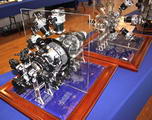
Don't forget the Annual Model Engineer Exhibition taking place at Sandown Park Racecourse (UK), from the 2nd to the 4th of November. As mentioned earlier, you will have the chance to see the Alex Whittaker Firefly being made, and listen to Alex who will give a daily talk on the Firefly project. Other SMEE lectures include Mike Crisp and Norman Billingham on making and hardening tools, Lester Caine on getting started with CNC, and Derek Brown on better model construction. You may also be able to grab ME and MEW Editor, Dave Clark, and bend his ear about the content of the magazines. Our teaser photo shows the Bristol Mercury Mk VIII by Mike Tull which will be on display for the delight and discouragement of model makers everywhere  .
.
Briefly Noted
This section is intended to alert you to little things that are hard to expand to a full news item, or cunningly wind into the Editorial, but are worthy of note never the less.
- Seems the update made to the Great Model Engine Review Index in September broke the "compare" feature. Also seems the Custom (advanced) Search feature has been broken for some time—perhaps as long ago as 2006! Both are fixed now, and thanks to the alert reader who pointed out the former, which led me to the latter. See? Writing in does help.
- We have an update to Adrian Duncan's Rivers Review. There are clarifications and expanded serial number information in both parts, with a new image showing the French-language Model Avia review of the Silver Arrow.
- An alert reader who knows how much I love having spelling errors pointed out has emailed to say the Engine Finder has got "Vivell" clipped to only one "L". To add injury to insult, the error appeared three times! It's probably been in this state about forever, but is fixed now and the MBI Vivell 09 page has been reworded slightly to release a temporal fixing. I'd say what the el, but that may be a bit obvious...
 Gildings 2012
Gildings 2012
 More Must Be Better
More Must Be Better
 Fitzpatrick 60
Fitzpatrick 60
 It Ain't Half Hot Mum
It Ain't Half Hot Mum
 Mini Mills
Mini Mills
 QSMEE Trophy Day
QSMEE Trophy Day
 The Model Engineer Exhibition
The Model Engineer Exhibition
 Editorial
Editorial
 New Books and Magazines This Month
New Books and Magazines This Month
 Engine Of The Month: Thermite
Engine Of The Month: Thermite
 Tech Tip of the Month
Tech Tip of the Month
 Briefly Noted
Briefly Noted
 Standard Stuff
Standard Stuff













 .
.